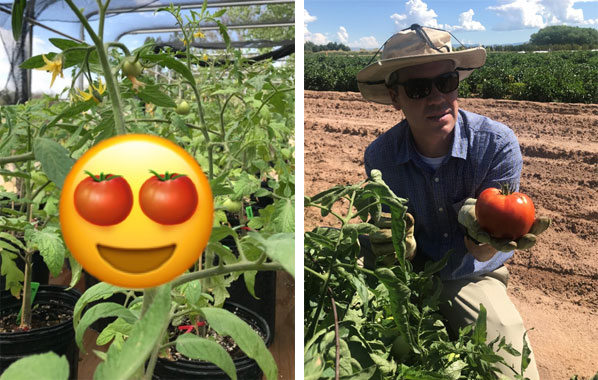October 24, 2020

Green with Tomato Envy
Partially reprinted column from October 2018
Question:
What should I do with all of these green tomatoes?
- Yours Truly, Los Lunas, NM
Answer:
I first answered this question way back in 2018. And here we are again, with first frosts snapping across the state and gardeners sharing photos of final harvests, many with green tomatoes piled high. The same questions keep coming up: What’s the best way to ripen them, and then what can be done with them?

If you’re a seed saver, you may want the fruits to ripen to maturity. The difference between a fruit being mature and one that’s ripe is that “maturity” refers to seed viability and “ripeness” is the most favorable state for consumption or use. Ripeness, then, is partly dependent on personal taste and the intended market. Many fruits, like grapes, pomegranates, and citrus, get more flavorful and achieve higher quality if allowed to ripen before being picked. Others, like bananas, pears, and avocados, are often picked when they’re technically mature but not completely ripe so that fewer rot during transport.
The difference has a lot to do with how much ethylene each fruit produces. Ethylene is a natural plant hormone (aka phytohormone or growth regulator) that is largely responsible for fruit ripening. The group of fruits that can ripen off the vine, so to speak, tend to be higher ethylene producers. Lucky for us, tomatoes are in this group. If you want to speed up the process of turning your tomatoes from green to red, store them with other red tomatoes (or another fruit that produces ethylene). If you want to slow the ripening process so that, for example, you still have red tomatoes to make salsa, go through the green pile occasionally and separate the red ones.
In this column a few years ago, we discussed the phytochemicals that give chiles their beautiful colors. In case you missed it: The color change in a chile fruit from green to red as it matures is indicative of the changing ratio of green chlorophyll to red carotenoid pigments. Lo and behold, the same is true in ripening tomatoes. Lycopene, famous for its health benefits as a powerful antioxidant, is in this red pigment group.
Here at the NMSU Agricultural Science Center at Los Lunas in 2018, we harvested almost 5,000 lb of tomatoes between August and the first frost; almost half of them were picked in October and were very green. Most of them turned red rapidly, but the green ones that were not mature (seeds not developed enough) never ripened.

I also remember the delicious loaves of green tomato bread that Valencia County Extension Master Gardener Lin Yeskie kindly baked (using a recipe from Dina Ortega’s sister) and delivered to our office that year. I’ve included the recipe below—feel free to quadruple it.
Green Tomato Bread
3 cups flour
2 cups sugar
1/4 teaspoon baking powder
1 teaspoon baking soda
1 teaspoon salt
1 tablespoon cinnamon
2 large eggs, slightly beaten
1 cup vegetable oil
1 teaspoon vanilla
2 cups finely chopped green tomatoes
1 1/2 cups chopped pecans
Preheat oven to 350°F. Mix flour, sugar, baking powder, baking soda, salt, and cinnamon. Stir in eggs, vegetable oil, and vanilla until just moist. Fold in green tomatoes and pecans. Pour into greased and floured loaf pans. Bake for one hour, or until a toothpick inserted into the loaf comes out clean. Let cool 10 minutes before flipping loaves out and cooling completely.
I still haven’t made it yet myself, but I already appreciate that whole green tomatoes get used and there are no extra messy steps of separating seeds.
Check out the NMSU Extension Guide E-306: Preserving Tomatoes at Home for great info on sanitation, canning, altitude adjustments, and several easy recipes for tomato juice, crushed tomatoes, several sauces, and more.
Marisa Y. Thompson, PhD, is the Extension Horticulture Specialist, in the Department of Extension Plant Sciences at the New Mexico State University Los Lunas Agricultural Science Center, email: desertblooms@nmsu.edu, office: 505-865-7340, ext. 113.
Links:
For more gardening information, visit the NMSU Extension Horticulture page at Desert Blooms and the NMSU Horticulture Publications page.
Send gardening questions to Southwest Yard and Garden - Attn: Dr. Marisa Thompson at desertblooms@nmsu.edu, or at the Desert Blooms Facebook page.
Please copy your County Extension Agent and indicate your county of residence when you submit your question!
